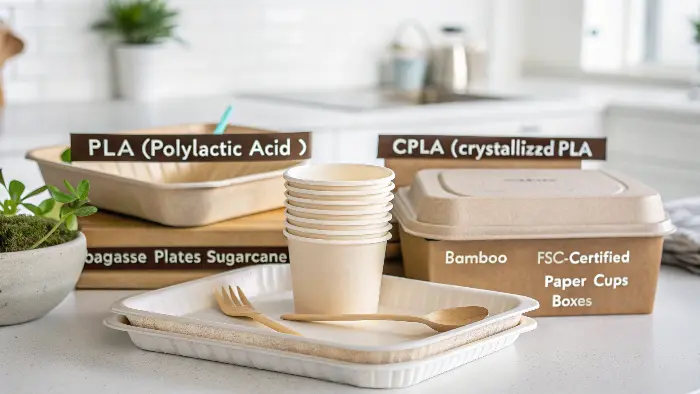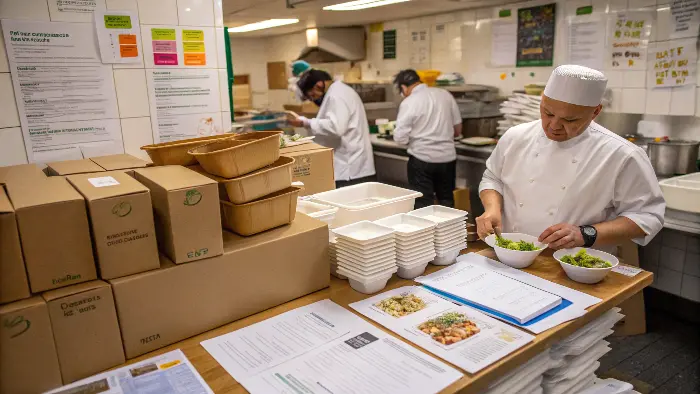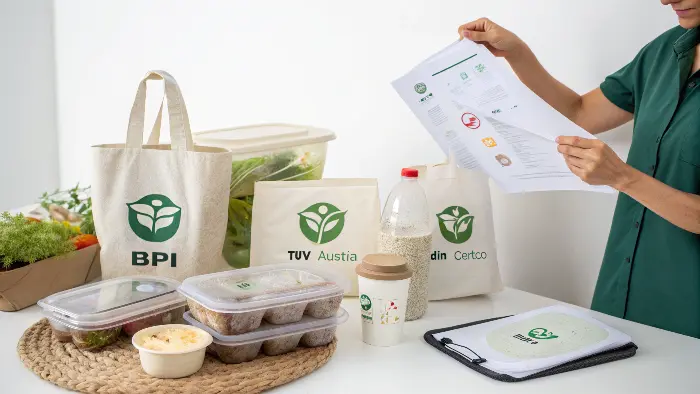Are you tired of plastic piling up, feeling the pressure to go green? You’re not alone. Sustainable foodservice items are becoming essential, not just a nice-to-have.
Yes, the sustainable foodservice market is experiencing significant growth. This is driven by consumer demand for eco-friendly options, stricter government regulations on single-use plastics, and businesses increasingly adopting corporate social responsibility initiatives. The main opportunities lie in innovative biodegradable materials and circular economy models.
It’s pretty clear that things are shifting, isn’t it? I mean, you see it everywhere. But just saying "it’s growing" doesn’t really help you, the business owner or packaging specialist, figure out what to do next. So, let’s dig a bit deeper than just the headlines and explore what’s really going on, and more importantly, how you can make the most of these changes. Trust me, understanding these trends is key to staying ahead.
What’s Really Fueling This Green Rush in Foodservice?
Seeing all this demand for eco-friendly stuff, but wondering what’s truly behind it? It’s more than just a fad; it’s a fundamental shift in thinking.
The primary drivers are heightened consumer awareness of environmental issues, government bans on single-use plastics, and the push for corporations to demonstrate sustainability. People want to feel good about their choices, and businesses are responding to that, and to regulations!
Honestly, it feels like a perfect storm, in a good way for the planet, of course! For years, many of us in the industry, myself included, have been talking about the need for change. But now, it’s like everyone woke up. I think a big part of it is visibility – those documentaries showing oceans choked with plastic? They hit hard. And it’s not just a small group of activists anymore; everyday people are asking questions. "Is this cup compostable?" "Do you have non-plastic cutlery?" I hear these questions all the time when I’m out, and I bet you do too.
Then you’ve got the governments stepping in. Let’s be real, sometimes a little regulatory push is needed to get things moving on a large scale. We’re seeing single-use plastic bans and taxes popping up all over the globe. This isn’t just a European trend anymore; countries in North America, Asia, and Australia are all getting on board. For a business, this means you have to adapt, or you could face fines or even lose customers. It’s no longer an option, it’s becoming a baseline requirement.
And finally, there’s the corporate side. Big brands, and even smaller ones, are realizing that sustainability isn’t just good for the planet, it’s good for business. Investors are looking at ESG (Environmental, Social, and Governance) factors. Customers are more loyal to brands that share their values. So, companies are setting their own ambitious sustainability goals. Someone like Jacky, our packaging specialist persona from Canada, is right in the thick of this, tasked by his company to find genuinely sustainable solutions that also work well and look good. It’s a massive shift, and it’s happening fast. At Ecosourcecn, we’ve seen a huge uptick in inquiries from businesses wanting to make the switch proactively.
Which Eco-Materials Are Actually Stealing the Show in Foodservice Today?
Okay, so the demand is there, but what are people actually using instead of plastic? It’s a whole new world of materials out there, and it can get confusing, fast!
Leading sustainable materials include PLA (Polylactic Acid) from cornstarch, CPLA (Crystallized PLA) for higher heat, bagasse from sugarcane, bamboo, and FSC-certified paper or kraft paper. Each offers unique benefits for different foodservice applications, from cutlery to containers.

It’s pretty exciting to see all the innovation happening! I remember when "eco-friendly" mostly meant flimsy paper plates. Oh, how times have changed! Now, we’ve got some seriously robust and good-looking options. Let me break down a few of the big players we work with a lot at Ecosourcecn, because choosing the right material is super important – it’s not one-size-fits-all.
Common Sustainable Material Choices
| Material | Source | Pros | Cons | Common Uses |
|---|---|---|---|---|
| PLA | Cornstarch, sugarcane | Compostable (industrial), clear, good for cold items | Lower heat tolerance, needs industrial composting | Cold cups, lids, cutlery, food containers |
| CPLA | Crystallized PLA | Higher heat tolerance than PLA, compostable (industrial), sturdy | Needs industrial composting, often opaque | Hot cup lids, cutlery, some food containers |
| Bagasse | Sugarcane pulp (byproduct) | Compostable (home & industrial), microwaveable, grease-resistant | Can absorb moisture over time, bulkier | Plates, bowls, clamshells, takeaway boxes |
| Bamboo | Bamboo plant | Rapidly renewable, strong, natural aesthetic | Can be pricier, not always compostable | Stirrers, skewers, some reusable tableware |
| Kraft Paper | Wood pulp (FSC certified) | Recyclable, biodegradable, often compostable, good for branding | Not always grease/waterproof without coating | Bags, boxes, food wraps, coffee cups (lined) |
When I talk to clients, like if I were advising Jacky, I’d first ask about the specific use case. Is it for hot liquids? Oily foods? Does it need to be transparent? For instance, PLA is fantastic for clear cold drink cups – looks almost like traditional plastic but it’s plant-based. But if you need something for hot soup, you’d probably look at CPLA for cutlery that won’t wilt, or a sturdy bagasse bowl. Bagasse, by the way, is a personal favorite of mine. It’s made from sugarcane waste – talk about a circular economy! It’s strong, looks good, and performs really well for things like takeaway containers. We help businesses navigate these choices, ensuring they get a product that not only meets their sustainability goals but also performs for their customers. It’s about finding that sweet spot between green and practical.
What Hurdles Might You Face When Going Green with Foodservice Items?
Switching to sustainable options sounds great, but let’s be honest, it’s not always a walk in the park, is it? There can be a few bumps in the road.
Common challenges include potentially higher initial costs, ensuring product performance matches conventional plastics, navigating "greenwashing" claims, managing supply chain reliability, and educating consumers on proper disposal for compostable or biodegradable items.

I’ve walked this path with many businesses, and believe me, I get it. The first thing that often comes up is cost. Yes, sometimes, sustainable alternatives can be a bit more expensive upfront than traditional plastics, especially if you’re looking at smaller volumes. But here’s something I always tell my clients: think about the total cost and the total value. What’s the cost of not switching? Potential loss of customers, negative brand perception, or even getting caught out by new regulations. Plus, as demand and scale increase, prices for eco-materials are becoming much more competitive. At Ecosourcecn, we work hard to source high-quality, affordable options.
Performance is another big one. Nobody wants a soggy paper straw or a compostable fork that snaps mid-bite! This is where thorough testing and choosing the right material for the job is critical. This is something Jacky, our packaging specialist, would be super focused on. He needs products that perform just as well, if not better, than what they’re replacing. That’s why we offer samples and work closely with clients to match products to their needs – PLA for cold, CPLA for heat, bagasse for sturdiness, you get the idea.
Then there’s the dreaded greenwashing. So many products claim to be "eco-friendly," but what does that really mean? It’s a jungle out there! This is where certifications come in handy, which I’ll talk about next. And finally, supply chain. Can you get these products consistently, especially if you need custom branding or large volumes? This is a core part of what we do at Ecosourcecn – ensuring reliable global logistics. It’s about building that trust so businesses know they won’t be left hanging. Oh, and don’t forget consumer education! If something is compostable, people need to know how to dispose of it correctly, otherwise, all that good effort goes to waste.
How Can You Be Sure You’re Picking Genuinely Eco-Friendly Products?
With so many "green" claims, how do you cut through the noise and find truly sustainable solutions? It’s a question I get asked almost every day!
Look for clear certifications like BPI (for North America, based on ASTM D6400) or TÜV Austria/DIN CERTCO (for Europe, based on EN13432) for compostability. Also, FDA/LFGB compliance for food safety is crucial. Partnering with transparent suppliers who provide documentation is key.

This is probably one of the most important aspects for anyone serious about sustainability, especially for someone in a role like Jacky’s. You need proof, right? You can’t just take a supplier’s word for it. Certifications are your best friend here. They provide third-party verification that a product meets specific standards.
Let me break down a few you should know:
- ASTM D6400 / BPI Certification: This is a big one in North America. If a product is BPI certified, it means it’s been tested and verified to break down in a commercial composting facility.
- EN13432 / TÜV Austria (OK compost HOME/INDUSTRIAL) / DIN CERTCO: These are the European equivalents, widely recognized globally. "OK compost HOME" is even better for some items as it means they can break down in a backyard compost bin.
- FDA (U.S. Food and Drug Administration) / LFGB (German Food and Feed Code): These aren’t strictly environmental, but they are absolutely essential for food safety. Any material touching food must comply.
- FSC (Forest Stewardship Council): If you’re using paper products, look for the FSC logo. It ensures the paper comes from responsibly managed forests.
When we at Ecosourcecn source products or work on private label solutions for our clients, these certifications are non-negotiable. We provide all the necessary documentation because we believe in transparency. It’s not just about having a "green-looking" product; it’s about genuine environmental responsibility and safety. I always advise clients to ask for these certificates. If a supplier is hesitant or can’t provide them, that’s a bit of a red flag for me. Building trust is paramount, and for us, that means showing our work and ensuring our partners, like Jacky, can confidently stand behind the products they choose. It makes their job easier and builds credibility for their brand. It’s a win-win.Conclusion
The shift to sustainable foodservice items isn’t just a trend; it’s the future. Opportunities abound for businesses ready to embrace eco-friendly solutions and meet growing consumer demand.


